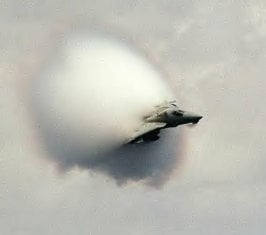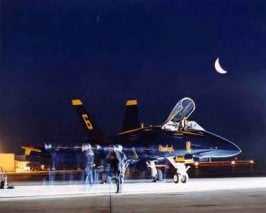Originally posted by KC
I never understood the "cobra" manuver the Soviet pilots were so proud of. Any aircraft with more thrust that weight can do the manuver.
The last time I saw the Blue Angels perform in OK city one of the pilots brought in his F18 with all surfaces extended. Landing gear down, speed brakes open, full flaps exposed, and the tailhook extended. He brought the plane in right at stall, must have been about 250 mph or less and skowly rotated it back until he was hovering about 200 feet above the runway. He balanced the plane on thrust alone. Rotated around on his tailfeathers to show everyone the top and bottom and then systematically raised the gear, closed the flaps, lowered the speed brakes, dilated the nozzles and went to full burn. He set the grass on fire and went straight into vertical ballistic flight until he was out of sight.
No doubt the Soviet pilots are good dogfighters and are also good at nap of the earth flight. These guys make do with less support than our pilots do as well, but the "cobra" manuver was just some candy for the press to latch onto. If you do a vertical stall in front of just about any decent fighter pilot you'll bleed off so much speed a missile cannot be avoided and you are a sitting duck. Especially with our fire-by-sight missile guidance systems. If the pilot can see the enemy, he can shoot the enemy and the plane does not have to be lined up to launch.
The really impressive stuff from the Soviet design bureau involve their directional vectored thrust systems on their latest Sukhoi fighters. Those things can turn around in less space than any other winged aircraft. There should be some videos online illustrating how these things can turn literally within their own length.
Hmm...let me just clarify some facts. Very FEW aircraft have a thrust to weight ratio greater than 1, that is, they generate more pounds of thrust then their weight. In fact, this is not a property of the F/A-18, the Blue Angels' planes. There are only 2 US fighters that enjoy this privilege, the new F-22 and the F-15. So, by saying "any plane" with that capablity to do this is a bit simplistic. Furthermore, the "cobra" isn't just going slow in "full dirty" (everything down) configuration. ANY plane can do what you said the Blue Angels did (minus the vertical blastoff

). In fact, this is precisley what airline pilots to to land. Airlines and any large jets are so big that they don't fly their approaches nose down. They control altitude simply by adjusting power, and control speed with external drag/lift devices.
The "cobra" is an extremley difficult SPECIAL maneuver. It is MUCH more then simply going in dirty and slow. The plane comes is regularly with external devices down, then pulls STRAIGHT up. The airplane then stalls, but the design of the airplanes that can do it (the Russian Su-27 and Mig-29) allow for extremley good high "angle of attack" manuevers (look angle of attack up somewhere

), so it can balance literally sitting on its tail for seconds, then punch it and exit the stall. THAT's a cobra. Not what you described. Furthermore, the aircraft has no external devices down, because they want minimal drag, and the only thing they want to slow them down is the pull up. I'm not sure if a speed brake is used, however. The key to the cobra is that a the point during which the plane is fully nose up, its ground speed, or speed of movement over the ground is LITERALLT 0.
I would say this is quite a bit different than waht you described. Futhermore, the cobra serves a purpose, as reports show that when performed it actually dissapears from radar for a few seconds, and even if it didn't, a missile going 2000 kts might overshoot the airplane with such a sudden speed change.
Hope this information informed you a bit better.

NOTE: The Thunderbirds have released video of an F-16 trying to a cobra, but it can't.




 ). In fact, this is precisley what airline pilots to to land. Airlines and any large jets are so big that they don't fly their approaches nose down. They control altitude simply by adjusting power, and control speed with external drag/lift devices.
). In fact, this is precisley what airline pilots to to land. Airlines and any large jets are so big that they don't fly their approaches nose down. They control altitude simply by adjusting power, and control speed with external drag/lift devices.









